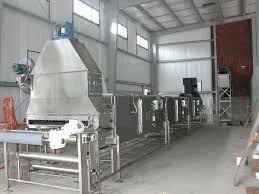Integrating Microwave Technology with Vacuum Conditions
A microwave vacuum dryer is a sophisticated piece of equipment that combines two powerful drying principles: microwave energy and vacuum atmosphere. These dryers use a sealed chamber in which a vacuum is created, reducing the air pressure around the material. Inside this low-pressure environment, water and other solvents evaporate at lower temperatures than they would at normal atmospheric pressure. This process is significantly enhanced by the introduction of microwaves, which directly heat the material, speeding up the drying process without the high temperatures needed in traditional drying methods.
Microwave Generation and Application
At the core of the microwave vacuum dryer, a magnetron emits microwaves at a frequency typically around 2.45 GHz. These microwaves penetrate the material placed inside the dryer, causing water molecules within the material to vibrate intensely. This molecular vibration produces heat which, combined with the low-pressure environment, results in rapid moisture evaporation. The ability to generate heat internally within the material, rather than through external heating, allows for remarkably uniform drying and is particularly beneficial for heat-sensitive materials.
Vacuum System Dynamics
The vacuum system in a microwave vacuum dryer plays a crucial role in the drying process. By lowering the air pressure to levels where water boils at temperatures as low as 30°C (86°F), the dryer can operate at much lower temperatures than conventional dryers. This not only preserves the quality of heat-sensitive products but also enhances drying efficiency. The system typically maintains a vacuum level of 1 to 10 torr (mm of mercury), which is significantly lower than atmospheric pressure.
Energy Efficiency and Quality Control
These dryers are not just about rapid drying; they are also incredibly energy efficient. By reducing the boiling point of water, the system requires less energy to evaporate moisture. This efficiency is further compounded by the direct nature of microwave heating, where energy is used almost exclusively for drying the material, not for heating air or the surrounding environment. This method ensures that up to 80% of the input energy is utilized effectively.
Safety and Operational Controls
Safety in operation is paramount. Microwave vacuum dryers are equipped with advanced safety features to handle the unique challenges posed by combining high-power microwaves with vacuum conditions. These include pressure relief valves to prevent vacuum pressure from becoming too low, microwave leakage detectors to ensure safe levels of microwave exposure, and interlocking doors that halt microwave generation when opened.
For more insights on enhancing your production efficiency with a microwave vacuum dryer, please visit our website.
This technology is revolutionizing drying processes across various industries, from food to pharmaceuticals, by providing a faster, more energy-efficient, and quality-preserving method. Its ability to dry delicately and efficiently makes it a top choice for industries upgrading their drying technologies.
